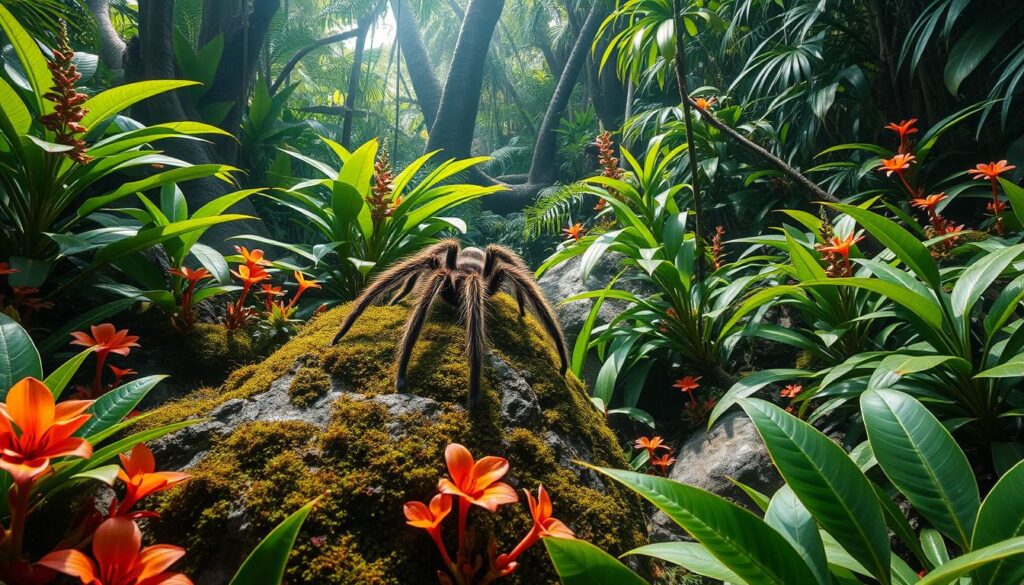Exploration of subtropical habitats and their biodiversity in relation to tarantulas

Let’s explore the world of subtropical ecosystems and the tarantulas that live there. What secrets do these habitats hold, and how do tarantulas adapt to their environments? We’ll dive into the subtropical biodiversity, where tarantulas are key to keeping the ecosystem balanced.
Subtropical areas worldwide are home to many tarantula species, each suited to its environment. These creatures live in everything from dense forests to dry grasslands. They fill different roles in their ecosystems, playing a big part in their health. Learn about their seasonal eating habits and see how they connect with their habitats.
What makes subtropical regions perfect for tarantulas? Their looks and behaviors help them survive in these complex places. Let’s discover the world of subtropical tarantulas and the secrets they hold.
Introduction to Tarantulas in Subtropical Regions
Subtropical regions have warm, humid climates, often between the tropics and temperate zones. These areas are full of life, including many tarantula species. Tarantulas here belong to genera like Brachypelma, Aphonopelma, and Grammostola. Each genus is adapted to its unique habitat.
Defining Subtropical Habitats
Subtropical habitats have moderate temperatures and high humidity. They have wet and dry seasons. These regions are often on the eastern sides of continents, between the tropics and temperate zones. The climate is warm all year, with some cool periods in winter.
Tarantula Species Found in Subtropical Areas
- The genus Aphonopelma includes species in the southwestern United States. For example, the Aphonopelma californicum can grow up to 5 cm long and has a leg span of 12.5 cm.
- In South America, the largest tarantulas are found. They belong to the genus Theraphosa. The goliath bird-eating spider (T. leblondi or T. blondi) can reach a body length of up to 7.5 cm and a leg span of about 30 cm.
- Other notable subtropical tarantula genera include Brachypelma and Grammostola. Each has its own special adaptations to the environment.
The tarantula taxonomy and arachnid diversity in subtropical habitats show how rich and complex these ecosystems are.

Biodiversity of Subtropical Ecosystems
Subtropical ecosystems are known for their subtropical ecosystem biodiversity. They have a wide variety of species across different levels in the food chain. This multitrophic diversity is key to keeping the ecosystem balanced. It does this by connecting producers, consumers, and decomposers in a way that supports nutrient cycling, energy flow, and the resilience of the environment.
In subtropical areas, invertebrate communities are very diverse. They include insects, spiders, and other arthropods that are crucial for the ecosystem. Tarantulas, being top predators, play a big role in these multitrophic webs. They help keep the ecosystem healthy and stable.
Importance of Multitrophic Diversity
Studies have found that plant diversity boosts ecosystem functioning by increasing multitrophic diversity. The link between multitrophic diversity and multifunctionality is stronger than the link between the diversity of single groups and multifunctionality. This is especially true in forests.
Insects are key to improving crop yields and biodiversity benefits. Species richness is more important for ecosystem functioning than species turnover in different elevations. Also, the decline of insects in grasslands and forests is linked to larger environmental factors.
Biodiversity across different levels is vital for ecosystem multifunctionality. Multitrophic arthropod diversity helps link plant diversity to primary productivity. Plus, biodiversity boosts multitrophic energy use, flow, and storage in grasslands. This shows why it’s crucial to protect the complex life systems in subtropical areas.

Habitats and Ecological Niches of Subtropical Tarantulas
Subtropical tarantulas live in many places, from dry rocks to green forests. Each type has found its own special spot in nature. They have special ways to live in their homes, like digging deep or making webs in trees. Knowing where they live and what they do is key to saving them and keeping nature balanced.
Tarantulas in subtropical areas like different habitats, such as:
- Dry, rocky areas with sparse vegetation
- Forested environments with dense canopy cover
- Moist, humid habitats near streams or wetlands
- Open grasslands and savannas
Each tarantula has its own special job in nature. Some hunt small rodents, while others catch insects. This way, they help keep their ecosystems healthy.
 Unique habitats of tarantulas on the island of Madagascar
Unique habitats of tarantulas on the island of MadagascarLearning about tarantulas’ homes and roles helps us protect them. This info helps with things like saving their homes, bringing back species, and keeping nature safe. It’s important for keeping the tarantulas and their homes safe.
Adaptations of Tarantulas to Subtropical Climates
Tarantulas live in warm, humid places and have special ways to survive. They have changed their bodies and how they act to deal with the heat and moisture. These changes help them live well in their subtropical homes.
Morphological Adaptations
Tarantulas in warm areas have thick shells and water-repelling hairs. These features protect them from the elements. They keep their bodies moist and don’t dry out in the heat and humidity.
Behavioral Adaptations
Tarantulas also act in ways that help them survive. They dig burrows to stay cool and control their body temperature. Some can even change how active they are to keep their body temperature just right.
These changes in body and behavior are key for tarantulas to live in subtropical places. By studying how they adapt, we learn more about their survival strategies. This includes their tarantula adaptations to subtropical climate, morphological adaptations, behavioral adaptations, and arachnid physiology.
Tarantulas in Subtropical Regions as Ecosystem Engineers
In the warm and lively subtropical areas, tarantulas are key ecosystem engineers. They change their homes with their complex actions and interactions. This helps shape their environments in big ways.
Tarantulas dig tunnels and holes underground. These spaces are safe homes for many other animals. They also help the soil breathe, let water in, and move nutrients around. These are key for keeping the ecosystem healthy and productive.
When tarantulas spin webs, they change the landscape. These webs catch prey and control the flow of energy and nutrients. This affects how other animals move and live in the area.
Tarantulas also play a big role in the food web as top predators. They eat many different insects, keeping their numbers in check. This helps shape the community and can affect the whole ecosystem’s balance.
By changing their environment, tarantulas act as ecosystem engineers. They are vital in creating the biodiversity and ecological balance in subtropical areas. Their actions help keep these ecosystems diverse and strong.
Threats to Subtropical Tarantula Populations
Subtropical tarantulas face big challenges that threaten their survival. Habitat loss and fragmentation are big problems, caused by humans. Things like cities, farms, and mining take over their homes. This breaks their habitats into smaller pieces, making it hard for tarantulas to live.
Another big threat is invasive species. These are animals that don’t belong in the area and can take over. They compete with native tarantulas for food and can even eat them. This balance upset can hurt the tarantulas’ chances of surviving.
We need to act to save these amazing spiders. By using good conservation plans, we can help protect their homes. This way, these incredible spiders can keep living for a long time.
| Threat | Impact | Mitigation Strategies |
|---|---|---|
| Habitat Loss and Fragmentation | Disrupts breeding, foraging, and dispersal patterns of tarantulas | Protect and restore critical habitats, implement sustainable land-use practices |
| Invasive Species | Outcompete native tarantulas for resources, prey on them directly | Implement biosecurity measures, control and eradicate invasive species |
| Interspecific Competition | Disrupts the delicate balance of subtropical ecosystems | Promote native species conservation, manage competitor populations |
Role of Tarantulas in Subtropical Food Webs
Tarantulas are key players in subtropical food webs. They act as both hunters and hunted. As predators, they keep the numbers of smaller creatures in check. This helps maintain balance in the ecosystem.
At the same time, larger animals like birds, mammals, and other spiders prey on tarantulas. This shows the complex relationships between predators and prey in these areas.
Predator-Prey Dynamics
Tarantulas are expert hunters, using their sharp fangs and venom to catch a variety of prey. This includes insects, small lizards, and rodents. Their hunting helps keep the tarantulas in subtropical food webs balanced.
 Adaptations of tarantulas to rural and agricultural environments
Adaptations of tarantulas to rural and agricultural environmentsOn the other side, tarantulas are a food source for bigger predators. These include owls, coyotes, and other spiders. This shows the predator-prey relationships that support invertebrate trophic interactions in subtropical areas.
Knowing how tarantulas fit into subtropical food webs is key to protecting these ecosystems. By understanding predator-prey dynamics, researchers can help manage these delicate systems. This knowledge is crucial for conservation and sustainable practices.
| Predators of Tarantulas | Prey of Tarantulas |
|---|---|
| Birds, such as owls and hawks | Insects, small lizards, and rodents |
| Mammals, such as coyotes and raccoons | Spiders, scorpions, and other arachnids |
| Other arachnids, such as larger spiders and scorpions | Small amphibians and reptiles |
Conservation Efforts for Subtropical Tarantula Species
Protecting tarantulas in subtropical areas is crucial. Many efforts are in place to save these amazing spiders and their homes.
Protected Areas and Reserves
Creating protected areas and reserves is a big part of saving tarantulas. These places keep endangered spiders safe from harm. Tarantula conservation efforts have made many protected areas in subtropical regions. This helps these unique creatures survive longer.
- In South Africa, there were about 64,701,000 tarantulas in 2024. The country has different landscapes that are perfect for many tarantula species.
- The Orange River and its rivers, covering 329,000 square miles (852,000 square km), are full of endangered arachnid species. These areas are key for conservation reserves.
- Protected areas like national parks and nature reserves are vital. They help keep protected areas safe for tarantulas and other animals.
Research, monitoring, and teaching the public are also key to tarantula conservation efforts. By learning more about these spiders, we can all help protect them. This way, we can make sure subtropical tarantulas keep thriving.
Impact of Climate Change on Subtropical Tarantula Habitats
Climate change is a big threat to the homes of subtropical tarantulas. Changes in temperature and weather patterns, along with more extreme weather, can harm their habitats. This can lead to less space, tarantulas moving away, and fewer tarantulas overall.
Subtropical areas are perfect for many tarantula types because they are warm and humid. But, the effects of climate change on tarantula habitats worry experts. These spiders are very sensitive to changes in their environment. This could greatly affect the subtropical ecosystem resilience.
It’s important to know how climate change affects tarantula habitats. By watching for changes in temperature, rain, and extreme weather, we can learn more about their challenges. This helps us find ways to protect these amazing spiders and the areas they live in.
We must keep a close eye on the impact of climate change on tarantulas. By understanding their weaknesses and the strength of their homes, we can make plans to save them. This will help keep these interesting spiders and their habitats safe for the future.
Cultural Significance of Tarantulas in Subtropical Regions
Tarantulas have a deep cultural meaning in many subtropical areas. They are seen as symbols of strength and spiritual power. This shows how important they are in these ecosystems.
In South America, people believe the tarantula has magical powers. Some groups link them to healing and shamanic rituals. In Asia, tarantulas symbolize good luck, wisdom, and a long life. They inspire stories and art.
The cultural significance of tarantulas goes beyond symbols. These spiders are part of many celebrations and ceremonies. When a tarantula shows up, it’s seen as a sign of good luck. This leads to special events and rituals.
Looking into arachnid symbolism and tarantula folklore and mythology helps us see how humans and tarantulas have lived together. It shows how important tarantulas are to local communities. This highlights their role in nature.
Future Research Directions and Opportunities
As we learn more about subtropical tarantulas and their homes, many research paths open up. We can dig deeper into their unique traits, actions, and roles in nature. We can also look into how threats like climate change and losing their homes affect them.
Creating new ways to protect tarantulas and their homes could bring big discoveries. This could help keep these tarantulas and other species safe.
Studying these amazing creatures helps us protect subtropical ecosystems. Research on subtropical tarantulas, their world, and how to save them is crucial. It can lead to better ways to protect them and the nature they live in.
 Description of tarantulas that inhabit coastal areas and their adaptations
Description of tarantulas that inhabit coastal areas and their adaptationsSubtropical areas are perfect for learning how tarantulas shape their environments. By studying their ways, we can better understand their survival in these changing places. This knowledge helps us make plans to save these vital species and the nature they support.



